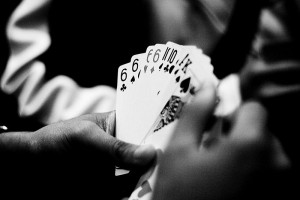Probability > Addition Rule
Contents:
The Addition Rule
The addition rule is used to find the probability that an event “A” or “B” happens. This could be individually or both at the same time. Examples of events that might happen at the same time:
- Getting a parking ticket if you’re unable to find a parking spot and have to park illegally.
- Buying a winning lottery ticket and that ticket being the jackpot ticket.
Set notation is usually used to calculate using the addition rule:
P(A∪B) = P(A) + P (B) – P(A∩B)
What this is saying (in English!) is the probability of event A OR event B happening (or both at the same time) is:
- The probability of event A happening on its own,
- Plus the probability of event B happening on its own,
- Plus the probability of both events happening at the same time.
Need help in working these probabilities? Check out our tutoring page!
The “mathy” way to write these probabilities:
- P(A) = probability that event A happens.
- P(B) = probability that event B happens.
- P(A∪B) = probability that either event A or event B happens.
- P(A∩B) = probability that event A and event B happen at the same time.
There are a couple of useful facts that you can use with the addition rule:
- If it isn’t possible for the events to happen together (called “mutually exclusive“) then P(A∩B) = 0. In this case, the addition rule just becomes P(A∪B) = P(A) + P(B).
- If the events have no influence on each other (“independent events“) then the addition rule becomes P(A∪B) = P(A) + P(B)-P(A) * P(B)).
A mutually exclusive event is one where there’s no chance of things happening together. For example, you can’t parachute out of an airplane if you never fly in planes. You can’t win the lotto if you don’t buy a ticket and you can’t get a speeding ticket if you never drive. Independent events have no influence on each other. For example, winning the lotto and finding that lost sock the dryer. Or getting a speeding ticket and a parking ticket on the same day.
Inclusion-Exclusion Principle
Brani Vidakovic (in Statistics for Bioengineering Sciences) defines the inclusion-exclusion principle in terms of the Addition Rule:
“If k events are exclusive and have n1 + n2,…,nk outcomes, then their union has n1 + n2,…,nk outcomes. If the events are not exclusive, this rule is known as the inclusion-exclusion principle.“
In other words, the total probability of a set of events is the sum of the individual probabilities of each individual event, minus the overlap (the probability of the events happening at the same time).
In Combinatorics, it’s the same principle, only instead of probabilities it is defined in terms of the union of two sets:
|A ∪ B| = |A| + |B| – |A ∩ B|
It has the same basic meaning: the total size of two joined sets is the size of the two sets added together, minus the overlap (the items that appear in A and B at the same time).
References:
Gonick, L. (1993). The Cartoon Guide to Statistics. HarperPerennial.
Kotz, S.; et al., eds. (2006), Encyclopedia of Statistical Sciences, Wiley.
Brani Vidakovic, (2011) Statistics for Bioengineering Sciences: With MATLAB and WinBUGS Support

Comments are closed.